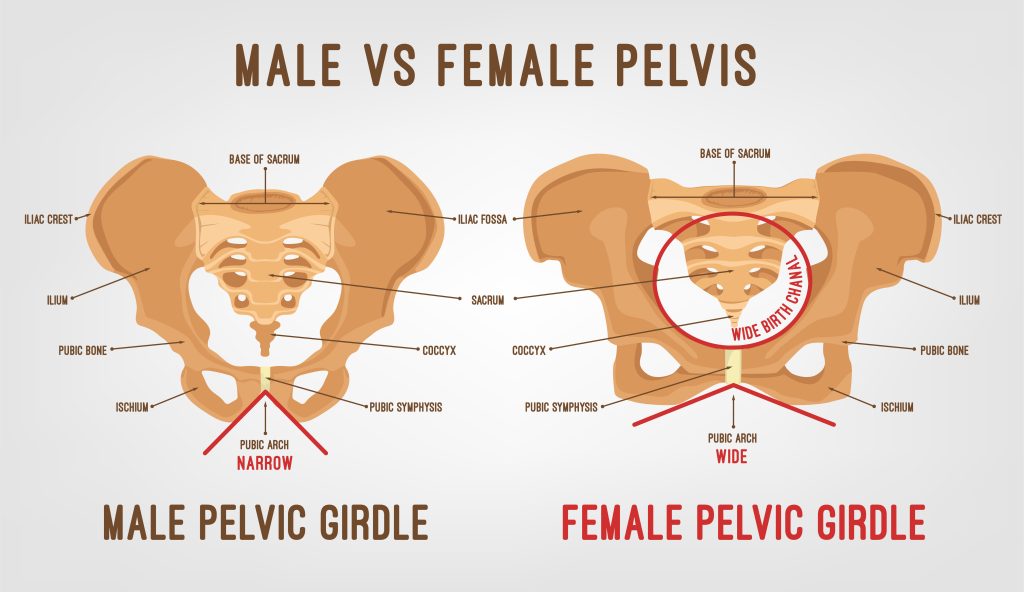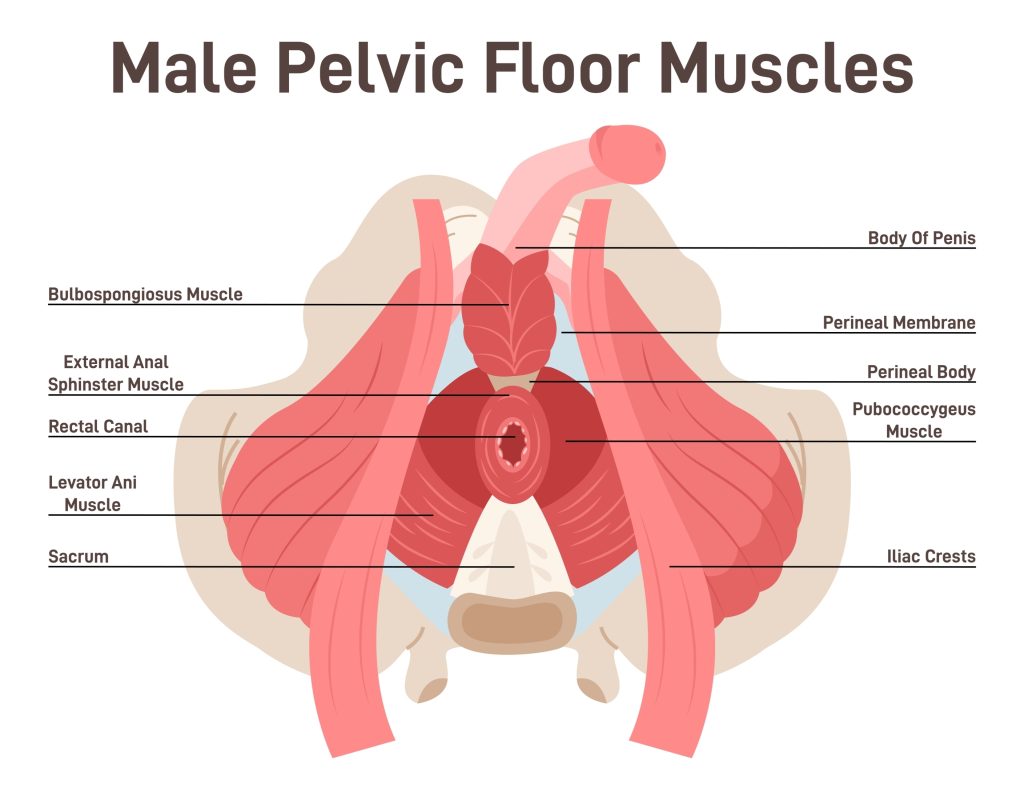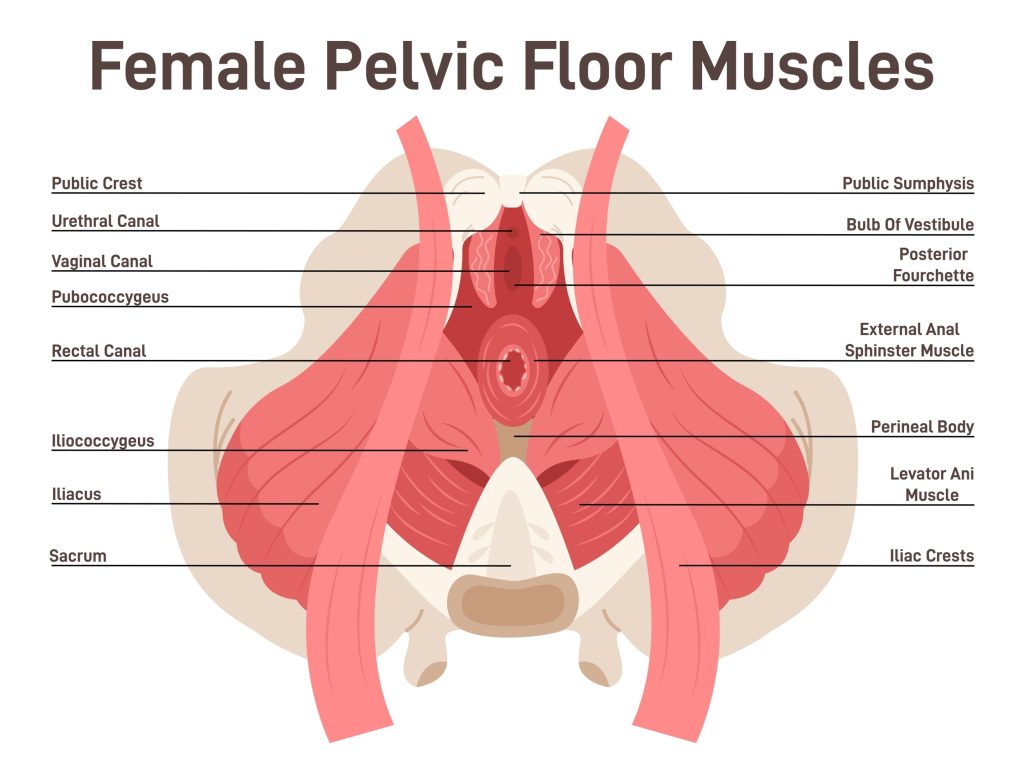
Muscles in the pelvic floor surround the anus and vagina and form a sling-like structure. Weak pelvic floor muscles can cause bladder and bowel control problems.
Anatomy Of The Pelvis
You can find the pelvic floor muscles at the bottom of a group of muscles commonly called the core. In addition to supporting the spine, they control the pressure inside the abdomen with deep abdominal (tummy) and back muscles.
A pelvic floor is a bunch of muscle and tissue. As a matter of fact, these layers are like a hammock. They stretch from the pubic bone to the coccyx (tailbone) and from the ischial tuberosity to the other side. They’re usually thick and firm.

Pelvic Floor Structure
A pelvic floor is funnel-shaped. To allow urination and defecation, there are two holes in the pelvic floor:
- An anteriorly situated gap lets the urethra (and vagina in women) pass through.
- A centrally positioned gap that allows the anal canal to pass through.
In between the urogenital hiatus and anal canal, there’s a fibrous node called the perineal body. It connects the pelvic floor to the perineum.
What Are The Pelvic Floor Muscles?
The pelvic floor muscles are a hammock of muscles that form the base of the pelvic region. They support the pelvic organs and play a role in urination, continence, and sexual function.
Pelvic floor muscles include:
- Levator ani muscle—a paired flat muscle that creates a sling around each side of the anus to support it when you stand, sit or walk.
- Coccygeus muscle—a triangular-shaped flat muscle that supports your tailbone and connects to your pubic bone (tailbone).
- Bulbocavernosus muscles—pairs of sphincter-like muscles at the opening where urine leaves your body.

Men’s pelvic floor muscles support their bladders and bowels. The urethra (urinary tube) and anus (back passage) pass through them.
In a woman, the pelvic floor muscles support her bladder, bowel, and uterus. The urethra (urinary tube), anus (back passage), and vagina pass through them.

These passages usually remain shut by the pelvic floor muscles, so it’s important to keep them strong.
Function
- Tonic contraction allows the abdominopelvic viscera (bladder, intestines, uterus, etc.) to stay in place.
- Assists in reducing intrapelvic/abdominal pressure during coughing and lifting.
- Muscle fibers contract and relax to allow the bladder and urethra to empty. Furthermore, this keeps the urinary tract and feces clean.
Symptoms Of Weak Pelvic Floor Muscles
There are several common causes, including:
- Female pregnancy and childbirth: In pregnancy, pelvic floor muscle dysfunction can begin, not just after birth. As a matter of fact, women with multiples, assisted births, or large babies are at higher risk.
- Menopause: As estrogen levels drop, pelvic floor muscles weaken.
- Straining on the toilet: A persistent or repeated strain on the toilet can make the pelvic floor weaker. The organs may even prolapse into the vagina (for women) or the anus (the rectal lining may protrude from the anus). Learn good toilet habits and figure out what causes constipation.
- Ongoing cough: Coughing for any reason (like asthma, bronchitis, or a smoker’s cough) increases the risk of incontinence.
- You may have weak pelvic floor muscles after a hysterectomy, prostate surgery, or radiotherapy.
- Heavy lifting: When lifting heavy things, make sure your pelvic floor is engaged first. Lift with good posture.
- High-impact exercise can leak urine more often, especially if you’re a woman.
- Age: We lose the strength of our pelvic floor muscles as we age. Pelvic floor muscle exercises can help them stay strong.
- Weight: Being overweight increases the likelihood of leaking urine and puts more stress on the pelvic floor.
- Feeling a bulge in your vagina when you move around
- Pain during sex or difficulty having sex
Signs Of Too-Tight Pelvic Floor Muscles
A hypertonic pelvic floor is when the pelvic floor muscles get too tight. Which means that the bladder and bowel don’t empty properly. This sign is less common than a weakened pelvic floor, but it’s still stressful.
Intercourse can be challenging if your pelvic floor muscles are tight. The pelvic floor, hidden from view, can go undiagnosed for a long time, and the causes can be complex. It’s best to see a women’s, men’s, and pelvic health physiotherapist.
Conclusion
The pelvic floor muscles are critical to your body’s overall health. They serve as a support system for organs and muscles in the lower abdomen area, including the bladder and rectum. If you are experiencing weak pelvic floor muscle symptoms, you must seek help from an experienced professional immediately.
A Note From Gulf Physio
We hope you’ve enjoyed learning about the subject matter above. This blog post is not a substitute for medical advice. The author cannot guarantee the accuracy of the information presented. If you have any questions or concerns, please consult a healthcare professional. All decisions and actions you make are your own. No one involved in making this resource is liable for its use.



